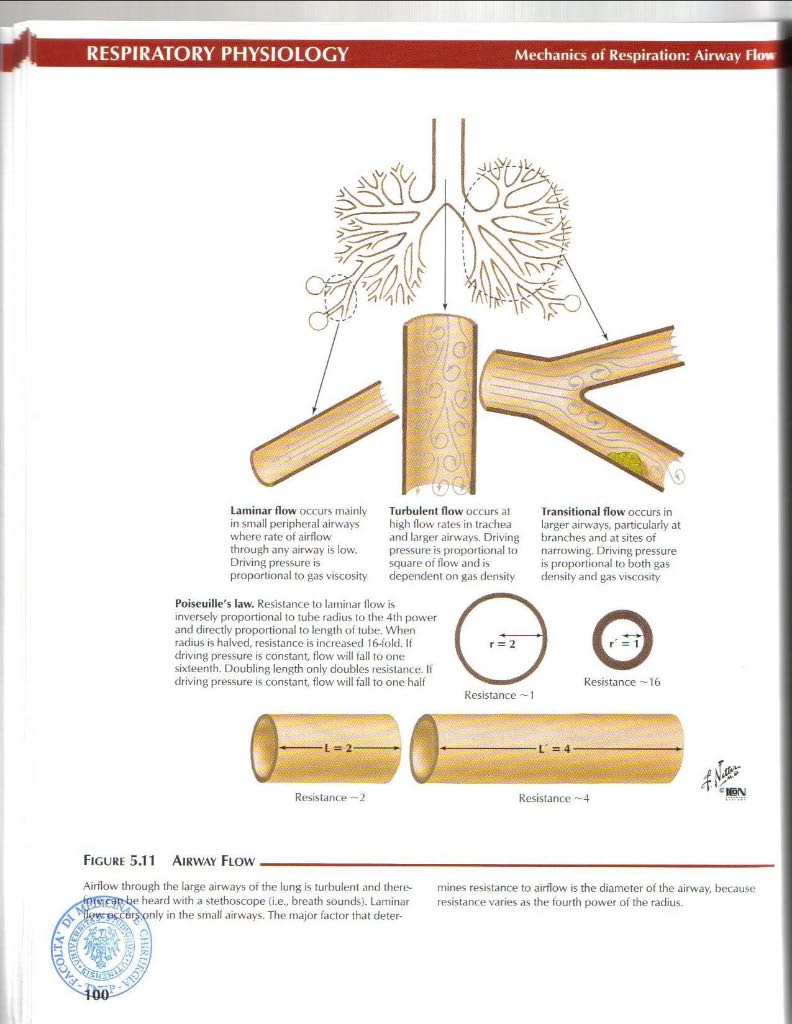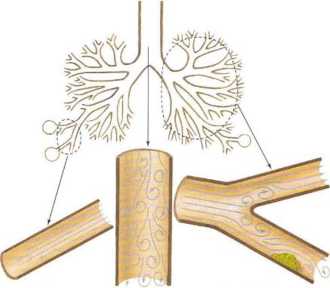netter85

RESPIRATORY PHYSIOLOGY
Mechanits of Respiration: Airway Flo»

Laminar flow occurs mainly in smali pcripheral airways where ratę ot airflow through any airway is Iow. Driving pressure is proporlional to gas viscosity
Turbulent flow octurs at high flow rates in trachea and larger airways. Driving pressure is proportional to square of flow and is dependent on gas density
Iransitional flow occurs in larger airways, particularly at branches and at sites of narrowing. Oriving pressure is proporlional to both gas density and gas viscosity

Resistance -1
Poiscuille's law. Resistance to laminar flow is mverseły proportional lo tubę radius to the 4th power and directly proportional to length ol lube. Wlien radius is halved, resistance is increased 16-lold. If drivmg pressure 15 constant. flow will fali lo one sixteenth. Dnubling length only doubles icsisiance. II driving pressure is constant. flow will fali to one hall

Resistance ~2 Resistance ~4
Figurł 5.11 Airway Flow
Airflow through ihe large airways of the lung is turbulent and thero-e heard with a stethoscope (i.e., brcath sounds). Laminar pnly in the smali airways. Tfłe major factor that deter-mines resistance to airflow is the diameter of the airway, bccause resistance varies as the fourth power of the radius.
Wyszukiwarka
Podobne podstrony:
47750 netter160 GASTROINTESTINAL PHYSIOLOGYAbsorption of Essential Elements and Vitamins Iron Elem
39142 netter65 HemodynamicsCARDIOVASCULAR PHYSIOLOCY Pressure Difference (AP) = Resistance to flow R
Metabolism biotransformation of toxins in the body occurs mainly in the liver for most drugs, but al
netter77 RESPIRATORY PHYSIOLOGYAirway Struclure: Intrapulmonary Airways Segmental bronchus Largo sub
netter89 RESPIRATORY PHYSIOLOGY Pulmonary Circulation Distribution of Pulmonar> Blood Flow
45953 netter81 RESPIRATORY PHYSIOLOGYMechanics of Rcspiration: Forces during Quict Breathin pressure
82393 netter97 RESPIRATORY PHYSIOLOGYRole of the Lungs in Acid-Base BaLar A. Role ot Lungs and Kidne
57087 netter79 Respiratory MusclesRESPIRATORY PHYSIOLOGY Muscles of Inspiration_A Muscles of
więcej podobnych podstron